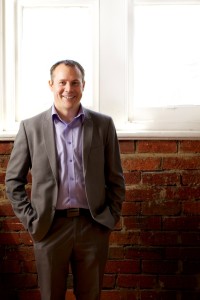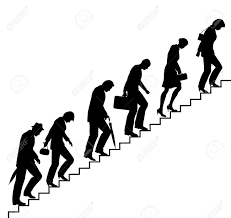 They say a picture is worth a thousand words and indeed, images can be very inspiring. When he was less than 10 years old, Craig Donaldson saw an image that has stuck with him for more than 20 years. It was a black and white cartoon – a small army of men in grey business suits with black briefcases – all trudging to work, with heads hung in depressed resignation that they each had to go to a mundane, unenjoyable job. It was poking fun at work and the day-to-day drudgery that many people experience.
They say a picture is worth a thousand words and indeed, images can be very inspiring. When he was less than 10 years old, Craig Donaldson saw an image that has stuck with him for more than 20 years. It was a black and white cartoon – a small army of men in grey business suits with black briefcases – all trudging to work, with heads hung in depressed resignation that they each had to go to a mundane, unenjoyable job. It was poking fun at work and the day-to-day drudgery that many people experience.
When he saw this, even as a youth, it made an impression. Craig knew that he wanted more for his life and career. He wanted happiness. Today, as the Editor of Sydney-based Inside HR Magazine, Craig has ownership for both words and images, and how they come together for long-lasting effect. Craig’s vantage point gives him unique expertise regarding work and life. In his Inside HR publication, he focuses on how organizations can realize results through strategic people management. It is in this way that he pays attention to job fit, engagement and happiness, and how these help companies realize results.
Self-awareness is a starting point. Craig says that self-awareness is critical to finding a career that will keep one happy, both inside and outside work. As a matter of fact, in working with CEOs, career experts, HR leaders and other executives around the world, he is surprised by how few emphasize self-awareness in this process. But when individuals have self-awareness, backed by the courage and motivation to take the necessary steps to find a job they love, this yields a happier life and plenty of obvious benefits. From a company perspective, self-awareness is also helpful because when employees are aware of their skills and passions; they and the company can more easily find the right-fit career. And when there is a good fit and happiness between the job and the employee, people are more likely to contribute valuable discretionary effort and put more of their best into the job – thus contributing to company results.
But where does self-awareness begin? For Craig, it started early. He can remember being a youth of 11 years old and rocking back in his chair at school, thinking about what to do with his life. He saw three choices.
- Having grown up in the Australian country-side, he loved animals so he considered being a veterinarian. Craig knew however, that the sometimes-necessary euthanizing wouldn’t be something he could do, so he ruled out that choice.
- Craig also thought about being a career advisor/coach – helping people find happiness inside and outside work through aligning their intrinsic talents with purposeful work.
- Craig also wanted to be a writer. He always excelled at spelling, grammar and the written word, so it seemed like a natural choice; and indeed it has been.
Following up on his boyhood career reflections, Craig graduated from university with a major in journalism as well as minors PR and advertising – and these set him on his professional path.
Many of us may not be in the ideal role today, but according to Craig, we can think of this as a terrific opportunity to build a bright future. Of course, not all of us can remember our 11-year-old selves as vividly as Craig does, but we can find fit by considering 1) what we’re intrinsically good at – our talents 2) what we like to do – our interests and passions, and 3) what we’re challenged by. When we’re aware of these, we can more easily make plans to develop in careers that fulfill us.
Work-life is also important to considering the best fit. It’s more challenging to integrate today, says Craig, because the complexity and pace of work have increased. Craig points to multiple studies that show that increasing numbers of people are struggling with establishing the right mix of work and life. Efficiency is the key, he says. When we make efficient use of technology to help us meet the demands of the job and when we work effectively, we are optimizing our time.
Craig describes a recent research project that is telling. An Australian nurse who spent several years working in palliative care asked terminal patients about their top five regrets in life. A large majority reported that they’d wished they’d spent less time at work and more time with their families. What matters most from the end-of-life vantage point is not the actual time we spend working, but quality time in a meaningful, purposeful career, balanced with spending time with the people we love and who matter most in our lives. For Craig, time with family looks like playing with his boys (aged 3 and 5), relaxing and spending time with his wife, and doing things together as a family on the weekends.
From a corporate perspective, Craig has seen some companies begin to implement creative solutions for work-life integration, and supporting employees in making time for their families. One multinational organization provided for ‘core hours’ where employees were required to be in the office 10am-3pm, but they could make choices outside of those hours to start early or stay late depending on their own preferences and convenience. He has seen other companies that are increasingly allowing employees to work from home when they do not have to be face-to-face with customers or team members. Another company is offering variable technology support depending on how much an employee is on the road. For example, since their sales people are on the road more frequently, they are afforded more technology including options such as laptops and better mobile technology. Those who work most frequently in the office are more likely to have a desktop computer and other supportive working arrangements.
In Craig’s experience, leaders also have a critical role to play in helping people find work-life integration and satisfaction. Leaders can ask questions in order to understand what their team members value, what their goals are, and what they get most excited about doing. With this understanding, leaders can help plan for short, medium, and long term actions that will provide opportunities for the employee to contribute to tasks and projects that will be most fulfilling. This approach turns out to be very good for both employees and for the organization.
Leaders and individuals can continually seek best-fit careers so that work and life integrate and so that careers are more fulfilling. This brings us back to that cartoon Craig described at the beginning – the one of the men trudging to work. “Why get out of bed in the morning,” asks Craig, “for anything else but to do something you love?” After all, this is the true expression of work-life integration and fulfillment – doing what we love – and what our 11-year-old self would have wanted for us.
*While this isn’t the image Craig saw originally, it feels like a reasonable reflection of the drudgery we can seek to avoid!
Would you like to tell your story? If so, let me know by emailing me at tbrower108@gmail.com. Why? One of the foundations of Bringing Work to Life is abundance: the idea that it is possible to find fulfillment, have it all, and avoid the trade-offs between work and life. After all, work and life aren’t separate things to be placed in containers, but part of an integrated whole of a satisfying life. Another foundation of Bringing Work to Life is the idea of multiple right answers. As we’re all seeking ways to bring work to life – and bring life to work – we can learn from each other’s unique solutions and stories. I’d love to learn about your story!
Tracy Brower is the author of Bring Work to Life by Bringing Life to Work: A Guide for Leaders and Organizations.

